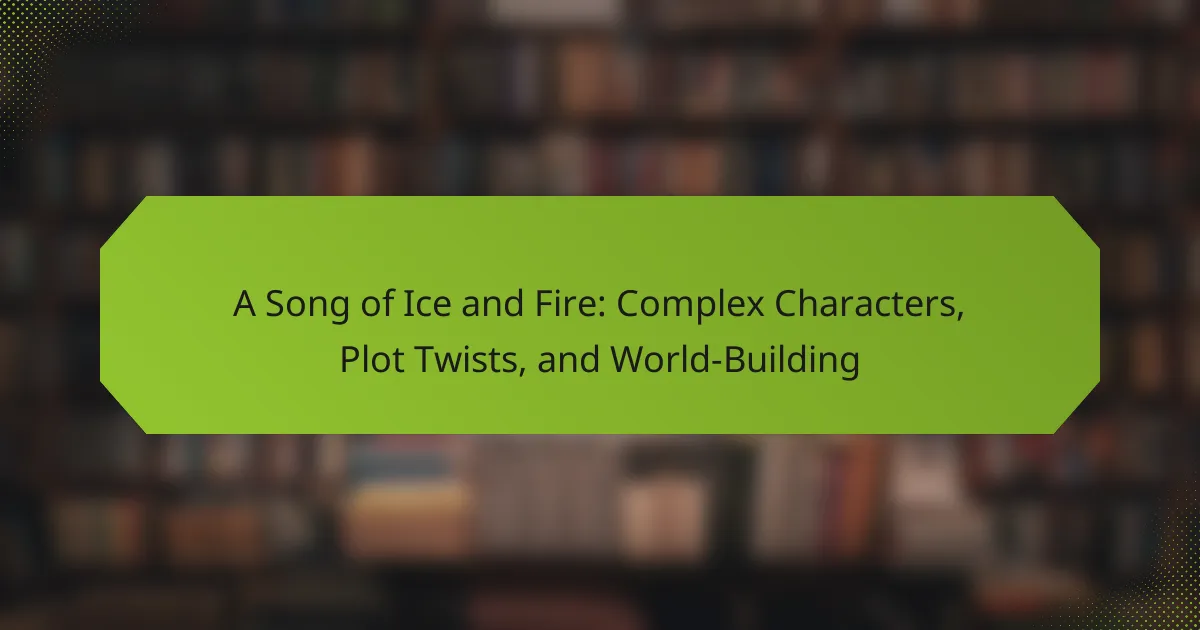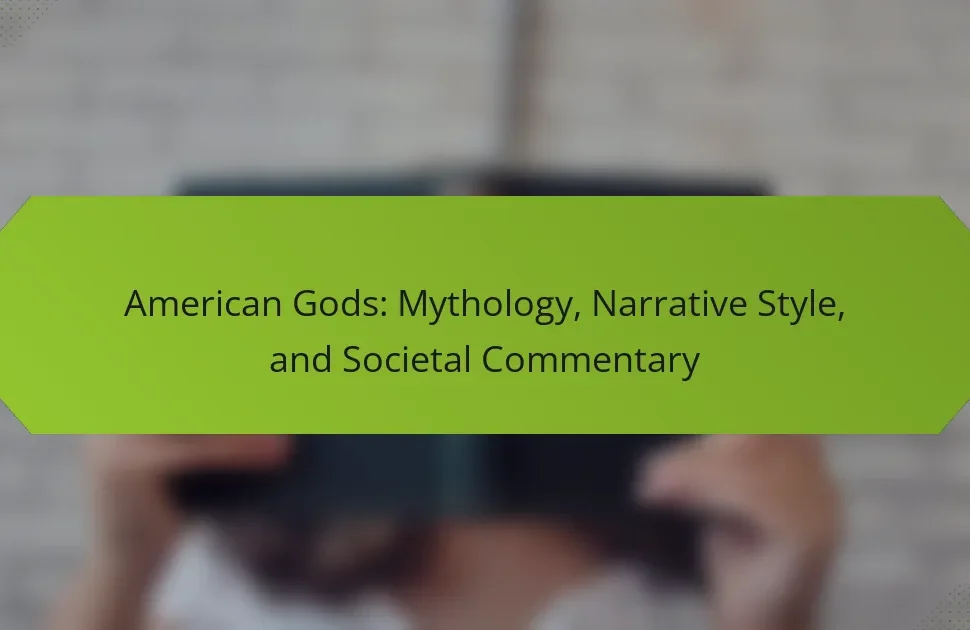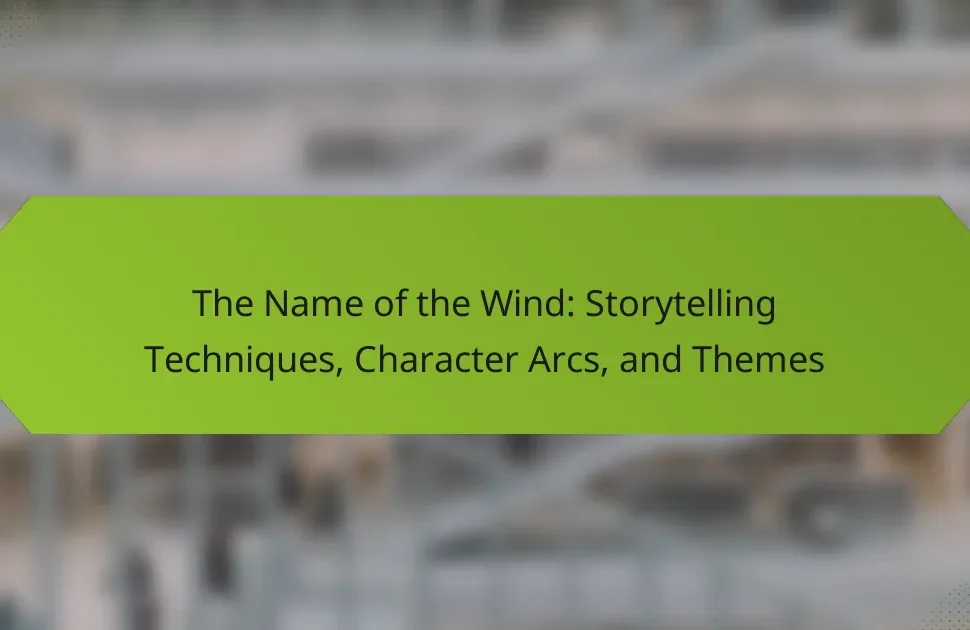A Song of Ice and Fire captivates readers with its complex characters, unexpected plot twists, and immersive world-building. The series explores intricate motivations and moral ambiguity, enhancing character depth. Plot twists subvert expectations and reveal hidden loyalties, while detailed world-building provides a rich backdrop for political intrigue. Themes of power struggles and human nature resonate throughout, inviting deeper analysis and engagement.
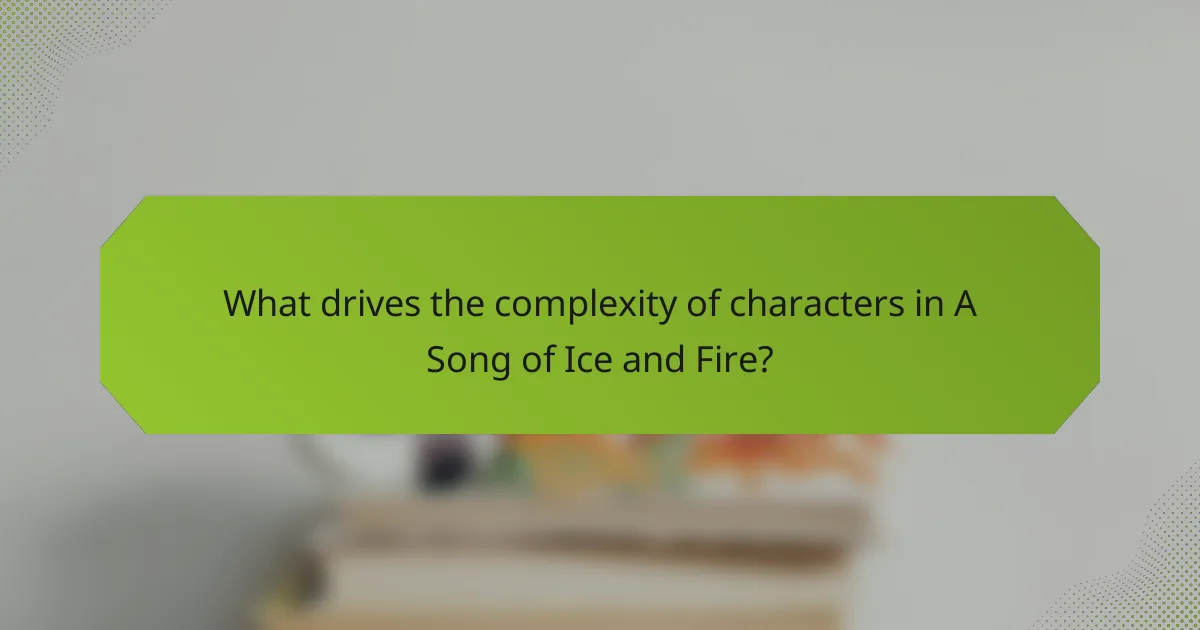
What drives the complexity of characters in A Song of Ice and Fire?
Complex characters in A Song of Ice and Fire emerge from intricate motivations, moral ambiguity, and rich backstories. These elements create depth, allowing characters to evolve in unpredictable ways. The interplay of power, loyalty, and betrayal further enhances their complexity. Unique attributes, such as the multi-faceted nature of characters like Tyrion Lannister and Daenerys Targaryen, illustrate this dynamic. As a result, readers experience a compelling narrative driven by character-driven plot twists and world-building.
How do character motivations shape their actions and decisions?
Character motivations significantly influence their actions and decisions in “A Song of Ice and Fire.” Each character’s unique desires, fears, and backgrounds shape their choices, often leading to unexpected plot twists. For instance, Tyrion Lannister’s cunning stems from his struggle for acceptance, driving him to make calculated moves in a hostile world. Conversely, Daenerys Targaryen’s quest for power and identity results in both heroic and destructive decisions. The complexity of these motivations enhances the narrative, creating a rich tapestry of conflict and character development. Understanding these motivations allows readers to anticipate potential outcomes and appreciate the intricate world-building that defines the series.
Which characters exhibit the most significant development throughout the series?
The characters with the most significant development throughout “A Song of Ice and Fire” include Jaime Lannister, Arya Stark, and Daenerys Targaryen. Jaime transforms from a seemingly arrogant knight to a more complex figure grappling with honor and redemption. Arya evolves from a noble girl into a skilled assassin, showcasing resilience and adaptability. Daenerys transitions from a timid exile to a powerful leader, embodying themes of ambition and morality. Each character’s journey highlights the intricate narrative woven by George R.R. Martin, emphasizing personal growth amidst political turmoil.
What role do alliances and betrayals play in character relationships?
Alliances and betrayals are crucial for character relationships in “A Song of Ice and Fire.” They create tension and drive the plot’s complexity. Characters often form alliances for survival or power, but betrayals reveal their true motivations. For example, the shifting loyalties among the Stark, Lannister, and Targaryen families illustrate the unpredictable nature of these relationships. This dynamic enhances world-building, as alliances can shift based on circumstances, leading to unexpected plot twists and character development. The interplay of trust and deception deepens the narrative, making it rich and engaging.
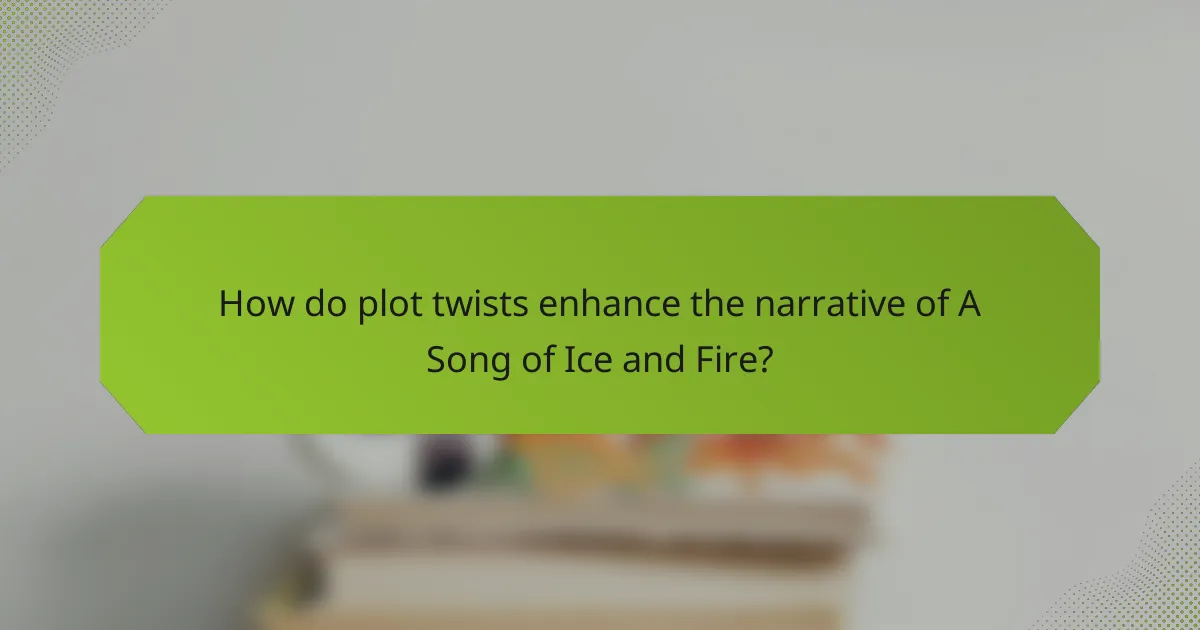
How do plot twists enhance the narrative of A Song of Ice and Fire?
Plot twists significantly enhance the narrative of A Song of Ice and Fire by subverting expectations and deepening character complexity. These unexpected turns create tension and intrigue, compelling readers to reevaluate characters’ motives and alliances. Notably, twists often reveal unique attributes of characters, such as hidden loyalties or secret identities, which enrich the world-building. The impact of these plot twists is magnified by the series’ intricate political landscape, where every choice can have far-reaching consequences, making the narrative unpredictable and engaging.
What are the most shocking plot twists and their impact on the story?
A Song of Ice and Fire features numerous shocking plot twists that dramatically alter character arcs and story trajectories. Key twists include the unexpected deaths of major characters, such as Ned Stark and Robb Stark, which subvert traditional storytelling expectations. These moments create a sense of unpredictability, enhancing the narrative’s tension and emotional impact. The revelation of Jon Snow’s parentage reshapes alliances and motivations, making it a pivotal plot twist that alters the power dynamics in Westeros. Each twist contributes to the series’ complex world-building, emphasizing the themes of betrayal and the harsh realities of power.
How do foreshadowing and misdirection contribute to plot twists?
Foreshadowing and misdirection create suspense and surprise in “A Song of Ice and Fire.” Foreshadowing hints at future events, building anticipation. Misdirection misleads readers, making plot twists more impactful. Together, they enhance the complexity of characters and the intricacy of the narrative, keeping readers engaged and guessing. This interplay deepens the emotional stakes and enriches world-building by revealing hidden layers in the story.
Which plot twists have become iconic within the fandom?
Iconic plot twists in “A Song of Ice and Fire” include the shocking deaths of key characters, such as Ned Stark and Robb Stark, which subvert traditional fantasy expectations. The revelation of Jon Snow’s true parentage is another significant twist that reshapes character dynamics and allegiances. The unexpected survival of characters like Catelyn Stark, who returns as Lady Stoneheart, adds a unique layer to the narrative. Additionally, the betrayal of Daenerys Targaryen by trusted allies creates tension and unpredictability within the storyline. These twists contribute to the series’ complex character development and intricate world-building.
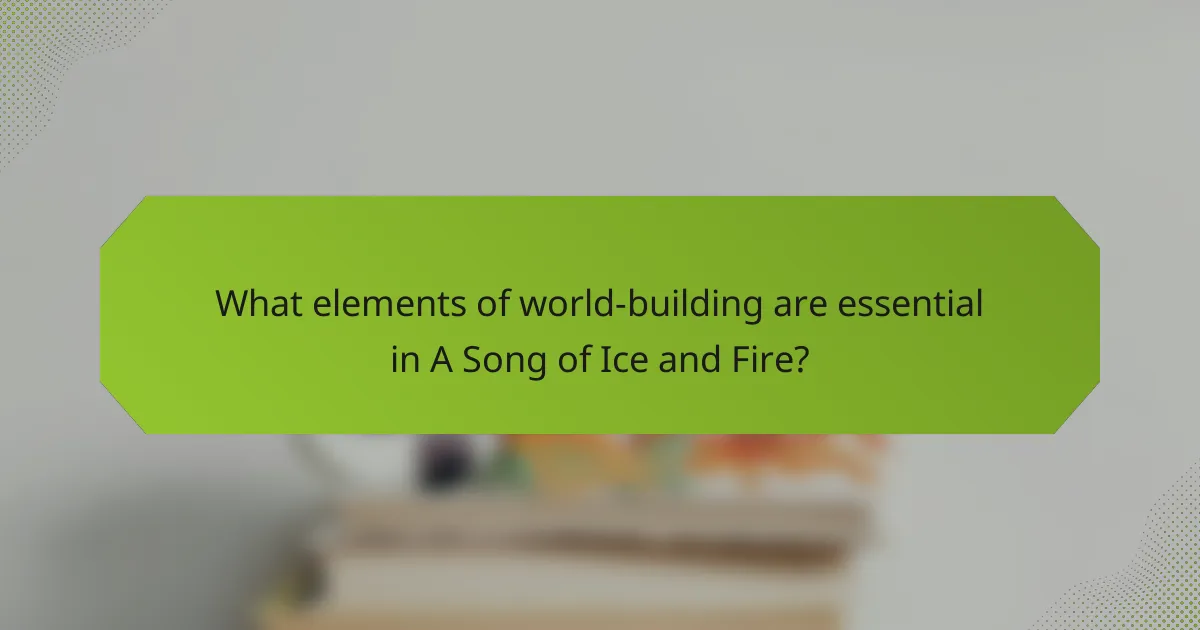
What elements of world-building are essential in A Song of Ice and Fire?
Essential elements of world-building in A Song of Ice and Fire include intricate geography, diverse cultures, and complex political systems. The detailed maps enhance the reader’s understanding of the vast world. Rich histories and lore provide depth, while the interplay of magic and religion adds intrigue. Character motivations are often influenced by these world-building elements, creating a tapestry of conflict and alliance.
How does geography influence the political landscape of Westeros?
Geography significantly shapes the political landscape of Westeros by influencing power dynamics and territorial disputes. The Seven Kingdoms’ varied climates and resources dictate the strength of noble houses. For instance, the North’s harsh winters affect its inhabitants’ resilience and loyalty. The Riverlands serve as a strategic crossroads, fostering alliances and conflicts. Coastal regions like Dorne and the Iron Islands leverage their geography for trade and naval power. Additionally, the Wall’s isolation creates a unique political situation regarding the Night’s Watch. Overall, geography is a crucial factor in the intricate political maneuvers of Westeros.
What cultural aspects are depicted through the various houses?
The various houses in “A Song of Ice and Fire” reflect distinct cultural aspects tied to their values and histories. House Stark embodies honor and loyalty, representing the North’s harsh environment and traditions. House Lannister symbolizes wealth and ambition, showcasing the power dynamics of the Westerlands. House Targaryen highlights themes of legacy and fire, reflecting their dragon heritage and the struggle for reclaiming the throne. Each house’s sigil and motto further encapsulate their identity, influencing alliances and conflicts throughout the series.
How does history shape the events and conflicts in the series?
History significantly influences events and conflicts in “A Song of Ice and Fire” through its intricate backstories and character motivations. The series is deeply rooted in the historical conflicts of Westeros, such as the Targaryen civil wars and the War of the Five Kings. These historical events shape the present dynamics among the noble houses, driving characters to seek revenge, power, or redemption.
Unique attributes, like the legacy of House Stark and the tragic downfall of House Targaryen, provide context for character actions and alliances. The impact of past betrayals and alliances creates a rich tapestry of intrigue, making the current conflicts more compelling. As a result, the interplay between history and personal ambition leads to unexpected plot twists, enhancing the narrative complexity.
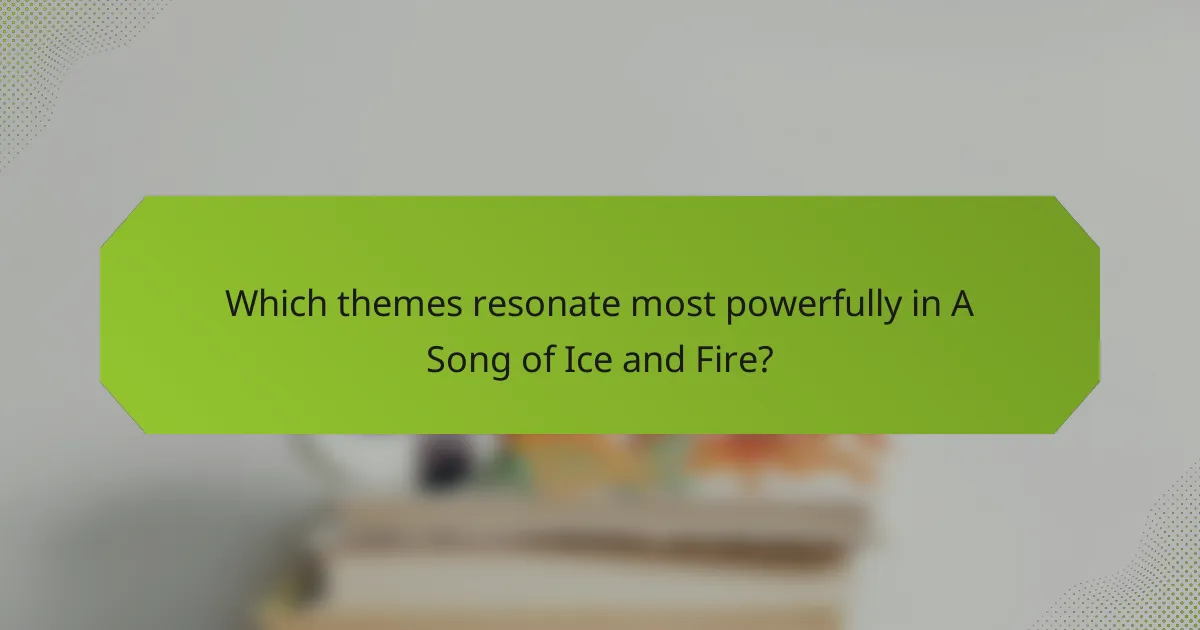
Which themes resonate most powerfully in A Song of Ice and Fire?
The themes that resonate most powerfully in A Song of Ice and Fire include power struggles, morality, and the complexity of human nature. Power struggles dominate the narrative, showcasing the lengths characters will go to achieve their ambitions. Morality is often blurred, with characters facing difficult choices that challenge their ethics. The complexity of human nature is explored through diverse character arcs, revealing motivations that drive actions. These themes create a rich tapestry that engages readers and prompts reflection on real-world issues.
How do themes of power and ambition manifest in character arcs?
Themes of power and ambition drive character arcs in “A Song of Ice and Fire” through complex motivations and transformative journeys. Characters like Daenerys Targaryen and Cersei Lannister embody ambition, showcasing how their quests for power lead to significant personal evolution. Daenerys begins as a pawn but transforms into a powerful leader, driven by her desire to reclaim the Iron Throne. In contrast, Cersei’s ambition leads her to ruthless decision-making, ultimately resulting in her downfall.
The interplay of power dynamics shapes relationships, as seen in the alliances and betrayals among characters. For instance, the evolving relationship between Jon Snow and Daenerys illustrates how ambition can create both unity and conflict. Additionally, the consequences of ambition often manifest in tragic outcomes, highlighting the moral complexities of pursuing power.
Overall, these themes are central to character development, revealing how ambition can inspire greatness or lead to destruction. The intricate world-building further enriches these narratives, providing a backdrop that amplifies the stakes of each character’s journey.
What is the significance of morality and ethics in the series?
Morality and ethics are central to character development and plot progression in “A Song of Ice and Fire.” The series explores complex moral dilemmas, challenging traditional notions of right and wrong. Characters navigate a morally ambiguous world, where decisions often lead to unforeseen consequences. This depth enriches the narrative, making the exploration of ethics pivotal to understanding the characters’ motivations and the overarching themes of power and survival. The unique attribute of the series lies in its refusal to provide clear moral guidance, reflecting the complexities of real-world ethics.
How does the theme of family loyalty affect character decisions?
The theme of family loyalty significantly influences character decisions in “A Song of Ice and Fire.” Characters often prioritize familial ties over personal ambition, leading to complex moral dilemmas. For instance, Ned Stark’s unwavering loyalty to his family ultimately results in his tragic fate. Similarly, Cersei Lannister’s actions are driven by her desire to protect her children, showcasing how loyalty can lead to ruthless decisions. This theme creates tension and drives plot twists, emphasizing the weight of familial obligations in a world rife with betrayal.

What techniques does George R.R. Martin use to create suspense?
George R.R. Martin employs techniques like complex character development, unexpected plot twists, and immersive world-building to create suspense in “A Song of Ice and Fire.” These elements engage readers by fostering emotional investment and unpredictability.
Complex characters often face moral dilemmas, making their choices uncertain and heightening tension. Unexpected plot twists disrupt anticipated outcomes, leaving readers on edge. Martin’s detailed world-building enriches the narrative, providing a backdrop where suspense can thrive through political intrigue and shifting alliances.
Additionally, the use of multiple perspectives allows readers to experience events from different angles, creating layers of suspense as they piece together the larger picture. This narrative style keeps readers guessing about characters’ fates and motivations.
How does narrative structure contribute to tension and anticipation?
Narrative structure in “A Song of Ice and Fire” heightens tension and anticipation through intricate character arcs and unexpected plot developments. By employing multiple perspectives, George R.R. Martin creates suspense, as readers are privy to conflicting motivations and hidden agendas. The nonlinear timeline further amplifies anticipation, as events unfold unpredictably, keeping readers engaged. Additionally, the rich world-building introduces high stakes, where character decisions can lead to dramatic consequences, enhancing the overall tension throughout the series.
What role does unreliable narration play in storytelling?
Unreliable narration enhances storytelling by creating suspense and deepening character complexity. In “A Song of Ice and Fire,” characters often present skewed perspectives, leading readers to question motives and truths. This technique allows for intricate plot twists, as revelations challenge initial assumptions. Additionally, unreliable narrators contribute to world-building by reflecting the multifaceted nature of morality and power in the series. This complexity invites readers to engage critically with the narrative, fostering a richer reading experience.
How do cliffhangers affect reader engagement?
Cliffhangers significantly enhance reader engagement by creating suspense and anticipation. In “A Song of Ice and Fire,” the intricate plot twists and complex characters are often left in precarious situations, compelling readers to continue. This technique fosters emotional investment, as readers become eager to discover outcomes. The strategic placement of cliffhangers throughout the series maintains a gripping narrative pace, ensuring that interest remains high. As a result, cliffhangers contribute to the series’ reputation for captivating storytelling and rich world-building.

How do fan theories enhance the experience of A Song of Ice and Fire?
Fan theories significantly enhance the experience of A Song of Ice and Fire by encouraging deeper engagement with its intricate narrative. They invite readers to explore complex character motivations, speculate on plot twists, and analyze the expansive world-building. This active participation fosters a community of fans who share insights, debate interpretations, and develop a richer understanding of the story. Theories often highlight unique attributes of characters and events, revealing connections that may not be immediately apparent. As a result, fan theories contribute to a more immersive and interactive reading experience.
What are some popular fan theories and their origins?
Popular fan theories in “A Song of Ice and Fire” often explore complex character motivations and unexpected plot twists. One notable theory suggests that Jon Snow is actually a Targaryen, stemming from clues in the text and character interactions. Another theory posits that Bran Stark is the Night King, based on his time travel abilities and the connection to the White Walkers. These theories originate from detailed analysis by fans who dissect character arcs and world-building elements, revealing deeper meanings and potential future events.
How do fan interpretations influence discussions around character motivations?
Fan interpretations significantly shape discussions about character motivations in “A Song of Ice and Fire.” These interpretations introduce diverse perspectives that challenge or reinforce existing narratives. Fans analyze character actions, revealing underlying themes and moral complexities. This engagement fosters a richer understanding of motivations, encouraging deeper analysis of plot twists and character development. Unique fan theories often highlight rare attributes of characters, prompting discussions that expand the narrative beyond the text. As a result, fan interpretations become a vital part of the discourse surrounding the series, influencing how characters are perceived and understood.
What impact do fan theories have on the series’ legacy?
Fan theories significantly enhance the legacy of “A Song of Ice and Fire” by fostering community engagement and deepening character analysis. These theories encourage fans to explore complex character motivations and intricate plot twists, enriching the narrative experience. As a result, the series remains relevant, sparking discussions that extend beyond the original text. The diverse interpretations of themes and world-building elements contribute to its lasting impact on popular culture.

What are common pitfalls to avoid when analyzing A Song of Ice and Fire?
To analyze A Song of Ice and Fire effectively, avoid oversimplifying characters and plots. Common pitfalls include neglecting character motivations, underestimating the significance of foreshadowing, and ignoring the intricate world-building. Failing to recognize the complexity of alliances and betrayals can lead to misunderstandings. Additionally, overlooking the impact of historical context on the narrative may diminish the richness of the analysis.
How can biases affect character interpretation?
Biases can significantly distort character interpretation in “A Song of Ice and Fire.” Readers often project their own beliefs and experiences onto characters, leading to varied understandings. This subjective lens can amplify or diminish character traits, affecting empathy and moral judgment. For instance, a character perceived as ruthless may be interpreted as a necessary leader by some, while others see them as a villain. Such biases create a spectrum of interpretations that enrich discussions but can also lead to misunderstandings about the author’s intentions and character motivations.
What are the dangers of overanalyzing plot details?
Overanalyzing plot details in “A Song of Ice and Fire” can lead to confusion and diminished enjoyment. Excessive scrutiny may obscure the intended themes and character motivations. This series thrives on complexity, so overthinking can detract from the immersive experience. Additionally, it risks missing subtle nuances and connections that enrich the narrative. Balancing analysis with appreciation is crucial for fully engaging with the rich world-building and intricate character arcs.
How can readers maintain an open mind while engaging with the text?
Readers can maintain an open mind by embracing the complexity of characters and plot twists in “A Song of Ice and Fire.” Engaging with the text requires an understanding that characters may not fit traditional hero or villain roles, challenging preconceived notions. Readers should be prepared for unexpected developments that can shift their perspectives on events and motivations. Additionally, immersing oneself in the rich world-building enhances appreciation for the narrative’s depth, allowing for a more nuanced interpretation of the story.
What best practices can enhance the reading experience of A Song of Ice and Fire?
To enhance the reading experience of A Song of Ice and Fire, focus on immersive world-building, character development, and narrative complexity. Engaging with supplementary materials like maps and character guides can deepen understanding.
Consider the following best practices:
1. **Read Character Arcs**: Pay attention to character growth and relationships to grasp intricate motivations.
2. **Track Plot Twists**: Keep notes on major plot developments to follow the evolving storylines.
3. **Engage with the Lore**: Explore the extensive history and cultures within the series to enrich your comprehension.
4. **Join Discussions**: Participate in fan forums to share insights and theories, enhancing the overall experience.
5. **Revisit Key Chapters**: Reread pivotal sections to catch nuances and foreshadowing that may have been missed.
